 |
 |
 |
| |
Summary from AASLD 2014 for Hepatitis C
Boston 7-11 November 2014
|
| |
| |
Feedback from the real-world: do HCV cure rates in real-life patient cohorts hold what clinical trials promised?
Summary from AASLD 2014 for Hepatitis C
Boston 7-11 November 2014
Jurgen K. Rockstroh M.D., Professor of Medicine
University of Bonn, Germany
Correspondence:
Prof. Dr. J.K. Rockstroh
Department of Medicine I
University of Bonn
Sigmund-Freud-Str. 25
53105 Bonn
Germany
Tel.: +49-228-287 16558
FAX: +49-228-287 15034
e-mail: juergen.rockstroh@ukb.uni-bonn.de
Introduction
After this year EASL it appeared as if numerous interferon- and ribavirin-free DAA combinations were emerging which all promised HCV cure rates above 95% and that other than cost and treatment access issues the revolution of HCV therapy was taking place at an incredible pace leaving little room for further optimization. One of the frequently raised caveats however, was the lack of data in the so-called more difficult to treat "real-life patients" with higher rates of previous non-response to IFN-based therapies and cirrhosis. Also data on more challenging patient groups with additional comorbidities such as renal impairment or from the transplant setting were still scarce. Which role would ribavirin play in the future? How short could HCV treatment duration possibly become? Clearly there were still many questions floating around from clinical practice. Therefore, this year AASLD was met with high expectations and interest as first data from the increasing use of DAA based HCV therapy from clinical practice outside of clinical trials was to be presented. A great summary on all HCV data was presented at AASLD (reviewing a proud number of 423 HCV presentations including 44 orals and 379 posters on HCV related topics) from Professor Fried and can be assessed through the AASLD website (1). The following conference report aims at covering the main HCV trials and clinical relevant HCV management issues presented at AASLD in Boston from 6-11 November 2014. It does not aim at completeness as the number of presentations on HCV therapy was higher than ever and covering all would produce an unreadable report but rather aims at capturing the main points of discussion with current HCV therapy.
Feedback from real-life
The first large cohort of HCV patients receiving DAA-based therapy was presented by Doug Dieterich on behalf of the TRIO network (2). Objective of the study was to evaluate outcomes with sofosbuvir and simeprevir regimens in a real-world, heterogeneous population. Data were collected through the Trio Platform directly from electronic Rx records in partnership with AcariaHealth, AllCare Plus Pharmacy, Aureus Health Services DBA Special Design Healthcare and other Specialty Pharmacies. Overall 1211 patients from 150 academic and community sites were included into this database. Results were presented for a subset of patients in whom HCV therapy had already been completed. Three main regimens were examined: SOF/PEG/RBV, SOF/RBV and SOF/SIM +/- RBV. Of 995 participants which could be analyzed 59% were male, 16% African-American, 30% had cirrhosis, 16% had platelets below 100K/µl, 43% were treatment-experienced (35% null responders, 65% partial responders/relapsers) and 20% had already received a HCV PI. All baseline characteristics already underline that this is a more difficult to treat patient population than normally enrolled into clinical trials. The SVR12 rates for the genotypes 1,2, and 4-6 are shown in figure 1.
Figure 1: SVR12 for Genotypes 1, 2, 4-6 (intent-to treat analysis)

Clearly there are two main messages. First overall cure rates in clinical practice remain high and suggest that even in real-life patients the high HCV SVR rates are reproducible but on average there is a 5% lower cure rate also indicating that there is a growing number of patients who have now failed under DAA-based therapy which will need more potent treatment options in the near future. This is particularly true for the more challenging patient populations as the cirrhotic genotype 1 patient with a history of previous HCV treatment failure . In figure 2 the decrease in overall SVR rates for the cirrhotic versus the non-cirrhotic patient is quite impressive. And this is true for all treatment regimens although SVR rates are highest in the Sofosbuvir/Simeprevir +/-Ribavirin combination. The other important feedback from this data base is that overall treatment discontinuation rates were extremely low with only 5%, hereof non-adherence 3% and adverse Events only 1.9%.
Figure 2: SVR12 for Treatment Experienced, Genotypes 1, Cirrhotic Status
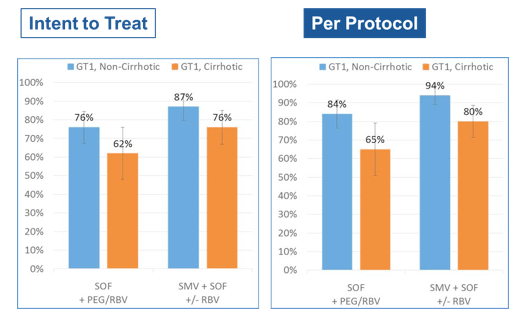
AASLD: Evaluation of sofosbuvir and simeprevir-based regimens in the TRIO network - Academic and community treatment of a real-world, heterogeneous population - (11/10/14)
Efficacy and safety of sofosbuvir and simeprevir: the real-life experience
HCV-TARGET is an ongoing longitudinal observational study at 43 academic and 13 community centers in North America (n=51) and Europe (n=5) (3). Overall 2330 HCV patients consented to be enrolled into this observational study. Demographic, clinical and virologic data and adverse events are collected throughout treatment and follow-up on sequentially enrolled patients, together with information on adherence to treatment futility rules at key time points. 52.2% of the included patients are already treatment experienced. 9.4% have already failed a first HCV PI based regimen. 48.4% had cirrshosis at baseline. 19.2% are already > 65 years old. 11.5% were black, 6.6% Hispanic. The study disposition and different HCV regimens collected are shown in figure 3.
Figure 3: Patient disposition in the TARGET study
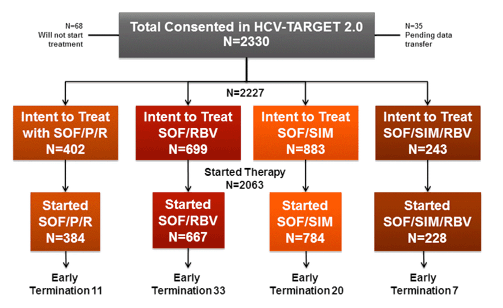
Overall virological response rates once again are very encouraging. In HCV genotype 1 patients with no cirrhosis receiving Sofosbuvir/PEG-IFN/Ribavirin SVR4+ was 90% (114/127) and 70% (26/37) in the cirrhotic subgroup. SVR4+ rates in GT 1 patients receiving Sofosbuvir/Simeprevir +/- ribavirin was 92% (113/123) in the patients with no cirrhosis and 87% (1566/180) in patients with cirrhosis. Patients with genotype 1a were a little bit less likely to achieve SVR4+ (89% (47/53) than patients with HCV genotype 1b (95% (88/93). No significant response rates were observed difference was seen for the Sofosbuvir/Simeprevir combination with or without ribavirin regardless of the subgroup examined (see figure 4).
AASLD: Safety and Efficacy of Sofosbuvir-Containing Regimens for Hepatitis C: Real-World Experience in a Diverse, Longitudinal Observational Cohort HCV-TARGET - (11/10/14)

Safety obtained from this study was very good with very low discontinuation and SAE rates. Adverse events of all oral regimens were much lower than those with PEG containing regimens.
Special populations
Many difficult-to-treat patient populations so far have been understudied although HCV treatment often represents a high priority in these particular patient groups. Therefore, the results from HCV treatment trials in patients with decompensated liver disease, patients on the transplant list as well as after transplantation, and patients with renal insufficiency will be summarized below.
Decompensated liver disease
108 GT 1 or 4 treatment-naïve or -experienced patients with decompensated cirrhosis (CPT class B [7-9] or C [score 10-12]) were included into a study where they were randomized to 12 versus 24 weeks of Ledipasvir/Sofosbuvir + Ribavirin (escalating doses starting at 600 mg/day) (4). Patients were ≥18 years of age and had not undergone liver transplantation. The protocol-defined efficacy endpoints were SVR (HCV RNA <15 IU/mL) 12 weeks after completion of treatment, safety, and tolerability. (See figure 5) (4). Patients were stratified by CPT score B (n=55) or C (n=53).
Figure 5: Study design

Patients were predominantly male (67%), Caucasian (93%), and had prior HCV treatment (65%). Mean baseline HCV RNA was 5.8 log10 IU/mL [range 3.2-7.1 log10 IU/mL]. 28 patients (26%) had a MELD score > 15. At baseline 96% of CPT class C patients had ascites and 88-91% encephalopathy for the 12 and 24 week arms, respectively. Three patients discontinued study treatment in the CPT class B group (2 underwent liver transplantation and 1 subject died) and 7 patients discontinued study treatment in the CPT class C group (2 underwent liver transplantation, 3 discontinued due to adverse events and 2 died). 28 patients (26%) experienced treatment-emergent serious adverse events (SAEs). Efficacy outcome is displayed in figure 6 below.
Figure 6: SVR12 rates by CPT class
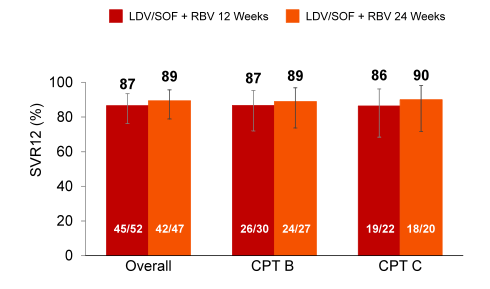
Clearly, the overall cure rates are very impressive in this particularly advanced patient population and suggest that 12 weeks of LDV/SOF + RBV are sufficient in CPT B as well as C patients. Obviously this implies quite some cost savings if treatment does not need to be extended to 24 weeks. The addition of ribavirin however, also implicates that this comes at least at the burden of some RBV-associated toxicities. The other very important observation from this trial was the quite drastic clinical improvement of the patients with successful HCV therapy which was documented by an improvement in MELD score as well as an increase in serum albumin all indicative of an improvement of liver synthesis function (See figure 7). This really has two important messages, one that it is clinically very worthwhile even to treat someone with Child-Pugh score C cirrhosis and secondly that treatment of HCV on the transplant list may lead to a delay in organ allocation as MELD score may improve quite dramatically. Nevertheless, some patients continued to show further increases in MELD score demonstrating that there may be a point of no return in late liver disease presentation.
Figure 7: Laboratory Results: MELD Score. Change From Baseline to Follow-Up Week 4.
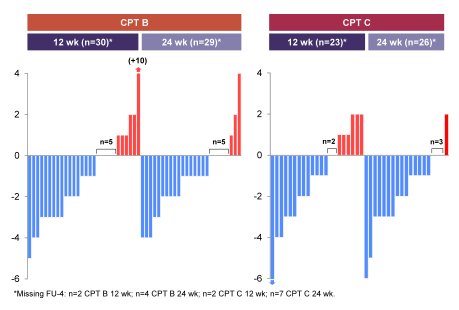
AASLD: Ledipasvir/Sofosbuvir With Ribavirin for the Treatment of HCV in Patients With Decompensated Cirrhosis: Preliminary Results of a Prospective, Multicenter Study - (11/12/14)
Compensated cirrhosis
Obviously, if DAA combination therapy works well in decompensated liver disease it should work even better in compensated cirrhosis. Questions which remain though are with regard to optimal treatment duration and the role of ribavirin. Therefore it was very interesting to see results of a large metaanalyses in compensated cirrhosis (5). Treatment-naïve or treatment-experienced patients with chronic HCV genotype 1 infection and compensated cirrhosis who had participated in Phase 2 or Phase 3 studies receiving LDV/SOF+/-ribavirin (RBV) for 12 or 24 weeks were included in this pooled analysis (including patients from LONESTAR, ELECTRON, ELECTRON-2, Japan phase 3 study, ION-1, ION-2, SIRIUS). 513 subjects with compensated cirrhosis were identified. The majority (91%) of patients had cirrhosis diagnosed by biopsy or fibroscan (>12.5 kPa). Of the 293 patients on whom a fibroscan was performed, 137/293 (47%) had a value >20 kPa. The majority were treatment-experienced (352, 69%), male (343, 67%), GT 1a (306, 60%), and IL28B non-CC (404, 79%). 240 (67% of the treatment-experienced patients) had previously received a protease inhibitor-containing regimen. 91 (18%) initiated therapy with a baseline platelet count of <90,000 cells/μL. 59 (11%) initiated therapy with a baseline albumin <3.5 g/dL. The patients received one of four regimens listed below in figure 8:
Figure 8: Study design: An Integrated Safety and Efficacy Analysis of >500 Patients with Compensated Cirrhosis Treated with LDV/SOF±RBV
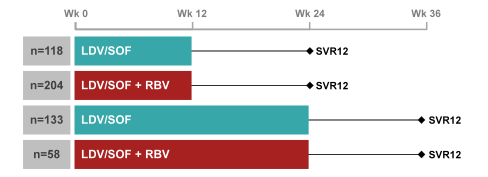
Looking at the efficacy outcome (See figure 8) it becomes clear that SVR12 rates are similar for 12 and 24 weeks of LDV/SOF ± RBV suggesting that 12 weeks are sufficient to cure the majority of patients. Safety in patients with cirrhosis was similar to that previously reported in patients without cirrhosis. Adverse events including anemia were more frequent in patients who received RBV. No other trends in adverse events or serious adverse events were noted.
Figure 9: Results: SVR12 by Treatment Duration

The next big question obviously was whether ribavirin was needed in this more difficult-to-treat patient population or not. Figure 10 depicts the SVR12 results by treatment regimen. Overall, SVR12 rates were high and on average for all treatment regimens ≥ 90%. Lowest cure rates was observed for 12 weeks of LDV/SOF in the treatment experienced patients. However, among treatment naive cirrhotic patients, 12 weeks of LDV/SOF + RBV resulted in similar SVR rates to 24 weeks of LDV/SOF alone. These findings would again suggest that there is a role for ribavirin in the more difficult-to-treat treatment experienced cirrhotic patients which would allow going for shorter treatment durations of 12 weeks which could implicate quite some cost savings. Extending treatment duration to 24 weeks for LDV/SOF also increased response rates in the cirrhotic treatment experienced patient group to 98%. Further subanalysis looking at impact of genotype (1a versus 1b), age or history of previous HCV PI failure detected no difference in SVR12 rates between the different patients subgroups examined. Further analysis examining the relation between important markers of liver disease stage and SVR12 rates showed that lowest response rates were observed in treatment experienced patients with low platelets (<75.000/ml) suggesting that more advanced portal hypertension may negatively impact HCV cure rates.
Figure 10: Results: SVR12 by Treatment Regimen

Randomized controlled trial in HCV GT1 patients with previous treatment failure and compensated cirrhosis
Within the above mentioned metaanalyses were also included the results from the French SIRIUS trial which were also presented at AASLD (6). In this double-blind, placebo-controlled study in cirrhotic GT1 patients who failed PegIFN+RBV or PI+PegIFN+RBV regimens in France (null or partial responders) 154 patients were included into two arms (See study design below in figure 11).
Figure 12: LDV/SOF in Cirrhotic Patients Who Previously Failed
PI-Based Triple Therapy: the SIRIUS trial (study design).

The mean age was 56 years (range 23-77). The majority were, male (74%), and IL28B non-CC (94%). Twenty-seven (18%) had a platelet count ≤100,000/μL and 20 (13%) had serum albumin <3.5 g/dL. 41 had varices at baseline. 30% of patients had participated in the CUPIC study. Treatment was well tolerated: all patients completed therapy except one who discontinued due to a serious adverse event of sepsis during the placebo phase of the study and was therefore excluded from the efficacy analysis per pre-specified criteria. Efficacy results are shown in figure 13.
Figure 13: LDV/SOF in TE Cirrhotic Patients: SVR12
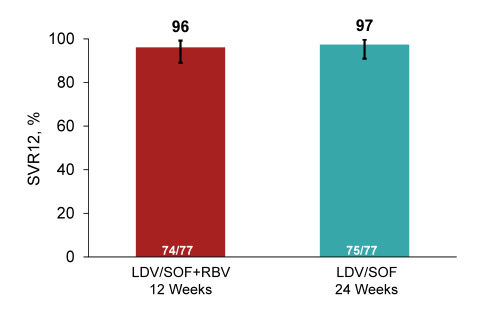
Treatment experienced cirrhotics had a similar response to LDV/SOF+RBV for 12 weeks
and LDV/SOF for 24 weeks. So again if RBV tolerant the combination of LDV/SOF + RBV appears the most cost-sensitive approach forward in cirrhotic treatment-experienced patients.
AASLD: An Integrated Safety and Efficacy Analysis of >500 Patients With Compensated Cirrhosis Treated With Ledipasvir/Sofosbuvir With or Without Ribavirin - (11/11/14)
AASLD: Ledipasvir/Sofosbuvir Fixed-Dose Combination Is Safe and Efficacious in Cirrhotic Patients Who Have Previously Failed Protease-Inhibitor Based Triple Therapy SIRIUS Trail - (11/11/14)
Treatment of recurrent HCV in liver transplant recipients
HCV infection is the most common indication for liver transplantation. However, HCV recurrence after liver transplantation is universal, leading to premature graft failure in 30-50% of patients. Interferon-based HCV therapies are limited by toxicity and poor efficacy. The current study examined safety and efficacy of ABT-450/r/ombitasvir and dasabuvir plus ribavirin(3D+RBV) in non-cirrhotic LT recipients with recurrent HCV genotype(GT) 1 infection (See figure 14) (7,8). Eligibility criteria included LT≥12 months before screening, HCV treatment-naive since LT, and screening biopsy Metavir score≤F2. Due to interactions between calcineurin inhibitors(CNIs) and study regimen, modified CNI dosing was advised (tacrolimus: 0.5mg once weekly or 0.2mg every 3 days; cyclosporine: 1/5 the daily pre-study dose once daily).
Figure 14: Study design of the CORAL-I study

3D: ABT-450/r/ombitasvir, 150 mg/100 mg/25 mg QD; dasabuvir 250 mg BID; RBV: Recommended to start with 1000-1200 mg divided into 2 daily doses and based on weight: <75 kg, 1000 mg; ≥75kg, 1200 mg
The excellent response rates are shown in figure 15. The overall cure rate was 97%. No patient had breakthrough on treatment and only 1 patient relapsed. The most common adverse events were fatigue, headache, and cough. Five patients (15%) required erythropoietin; no patient required blood transfusion. One patient discontinued the study drugs owing to adverse events after week 18 but had a sustained virologic response. Blood levels of calcineurin inhibitors were monitored, and dosages were modified to maintain therapeutic levels; no episode of graft rejection was observed during the study. In summary, treatment with the multitargeted regimen of ombitasvir-ABT-450/r and dasabuvir with ribavirin was associated with a low rate of serious adverse events and a high rate of sustained virologic response among liver-transplant recipients with recurrent HCV genotype 1 infection, a historically difficult-to-treat population.
Figure 15: CORAL-I: Efficacy results
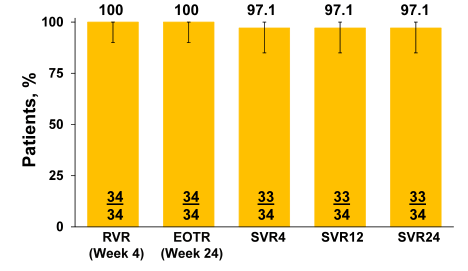
AASLD: HIGH SUSTAINED VIROLOGIC RESPONSE RATES IN LIVER TRANSPLANT RECIPIENTS WITH RECURRENT HCV GENOTYPE 1 INFECTION RECEIVING ABT-450/r/OMBITASVIR + DASABUVIR PLUS RIBAVIRIN - (11/12/14)
In a further study in liver transplant patients efficacy and safety of ledipasvir/sofosbuvir was assessed (9). GT 1 and 4, naïve and treatment-experienced patients with HCV infection, who were post liver transplantation (fibrosis score F0-F3, CPT class A, B and C with cirrhosis) with an estimated glomerular filtration rate (GFR) > 40 mL/min, received 12 or 24 weeks of LDV/SOF FDC with RBV (See figure 16). The primary efficacy endpoints were SVR (HCV RNA <15 IU/mL) 12 weeks after completion of study treatment, safety and tolerability. All patients were stratified at screening: F0-F3, CPT A, B, C. Ribavirin was dosed weight based in patients with low to moderate fibrosis (F0-F3) and in CPT A whereas dose escalation from 600-1200mg was performed in CPT class B and C.
Figure 16: Study design

To date, 223 patients have been randomized and treated. Most were male (83%), Caucasian (87%), and had prior HCV treatment (83%). The median time since liver transplant was 4.4 years (0.4-23.3). Mean baseline HCV-RNA was 6.4 log10 IU/mL [range 2.4-7.8 log10 IU/mL]. Mean GFR was 65.5 [range 20.4-118.9 mL/min]. 111 patients had F0-F3 fibrosis, 52, 51 and 9 patients had CPT class A, B, and C cirrhosis, respectively. The overall, SVR12 rates by treatment strata is shown below in figure 17.
Figure 17: Results: SVR12

Overall, lower cure rates were obtained in more advanced liver disease stages but as numbers of patients becomes very small conclusions are limited. Also it is important to keep in mind that with the excellent response rates in modern DAA combination therapy in liver transplant recipients earlier treatment after OLTX will become standard which makes the development of more advanced CPT scores rather unlikely.
The most common adverse events were fatigue, anemia, headache and nausea. 9 SAEs in 8 patients were considered related to study treatment; anemia (4) and hemolytic anemia (2), sick sinus syndrome (1), sinus arrhythmia (1) and portal vein thrombosis (1). 5 patients with cirrhosis died while in the study due to; internal bleeding, multiorgan failure/intestinal perforation, cardiac, complications of cirrhosis and progressive multifocal leukoencephalitis. Median serum creatinine and INR remained at baseline levels throughout treatment. Consistent with patients who have moderate renal impairment and who are receiving RBV, hemoglobin values decreased 2-3 g/dL while on treatment. 33 patients received concomitant epoetin or blood transfusions. Clearly getting rid of the ribavirin in the future still appears very attractive in sight of the hematological toxicities noted in the trial.
AASLD: Ledipasvir/Sofosbuvir With Ribavirin for the Treatment of HCV in Patients With Post- Transplant Recurrence: Preliminary Results of a Prospective, Multicenter Study - (11/11/14)
Additional interesting data came from an analysis from the daclatasvir compassionate use program which evaluated daclatasvir based all oral antiviral therapy in liver transplant recipients with severe recurrent HCV (10). 23 patients received DCV + SOF ± RBV and 7 DCV + SMV ± RBV. In this ongoing trial 79% of patients were undetectable at end-of-treatment (EOT) (n=24) and 75% (n=12) were negative >12 weeks after achieving EOT. Reassuringly mean CTP scores improved from 7.3 to 5.8 at last contact (P = 0.004, n=20). These findings reassure the field once again that IFN-free treatment options are emerging for this particularly challenging patient group.
As a feedback from the real life clinical setting a subanalysis from the large observational TARGET cohort was also reported which demonstrated very high early SVR4 response rates in post liver transplant recipients receiving sofosbuvir + simeprevir +/- ribavirin (11). SVR4 rates were 94% (29/31) in non-cirrhotic patients and 86% (32/37) in patients with cirrhosis. Genotype 1b patients had somewhat higher SVR4 rates than genotype 1a patients with 95 and 86%, respectively. Again, these data underline the high level of concordance between cure rates obtained from clinical trials versus from real-life observational cohorts.
AASLD: Safety and Efficacy of New DAA---based Therapy for Hepatitis C Post---Transplant: Interval Results from the HCV---TARGET Longitudinal, Observational Study - (11/11/14)
AASLD: Preliminary results of a Daclatasvir (DCV) based treatment protocol (DCV+Sof, DCV+Simeprevir) in LT recipients with severe recurrent HCV - (12/01/14)
Treatment of HCV in patients with renal insufficiency
Clearly treatment of HCV in patients with renal insufficiency is one further very important data gap. At this year AASLD first data was presented in patients with renal failure (12,13). As compared to those with normal renal function, the AUC0-inf of SOF is 2.7-fold higher in patients with severe renal impairment, and the AUC0-inf of GS-331007, the renally excreted major SOF metabolite, is 5.5-fold higher. Ed Gane presented a pilot study at AASLD which investigated the safety, efficacy and PK of SOF+RBV in HCV-infected patients with severe renal impairment (12). In an open-label study, 10 patients with chronic HCV GT1 or 3 with creatinine clearance (CrCl) less than 30mL/min as calculated by the Cockcroft-Gault equation, not on dialysis, received SOF 200mg + RBV 200mg daily for 24 wks. Patients included by genotype were: Gt 1a: n=7, Gt 1b: n=2 and Gt 3a: n=1. Overall SVR12 was 40%, 20% of patients discontinued, anemia was frequent and 50% of patients received EPO. SOF levels were similar to 400 mg in patients without renal insufficiency but GS-331007 levels were 4x higher. Overall safety and tolerability however was good.
Additional data was presented as a poster by Bhamidimarri et al. who shared his experience with the use of sofosbuvir based regimen in patients with GFR < 30ml/min who urgently need hepatitis c treatment (13). Overall 4 male patients with HCV genotype 1 (50% 1a), mean age 58 years who had severe renal insufficiency defined by GFR < 30ml/min or those who were on dialysis were presented. Two cirrhotic patients with ESRD on dialysis were being evaluated for combined liver kidney transplant who had normal hepatic synthetic function (mean albumin 4.3, INR 1, Bilirubin 0.5) and were disinclined to undergo liver transplantation (LT) were started on sofosbuvir 400mg every other day and simeprevir 150 mg every day. One liver transplant recipient developed fibrosing cholestatic hepatitis (FCH) within 3 months post LT with ascites, bilirubin 27 and severe renal impairment requiring dialysis and was started on compassionate sofosbuvir 400mg daily and ribavirin 200mg every other day. The fourth patient was a post liver-kidney transplant recipient who developed acute antibody mediated rejection of the kidney requiring intense immunosuppressive therapy and thus was started on sofosbuvir 400mg every other day and simeprevir 150mg daily. The outcome and patient courses are depicted below in figure 18. Even these are only few cases it at least demonstrates that with dose adaptation HCV therapy may be delivered even in the setting of severe renal insufficiency. Clearly additional data would be highly welcome to increase the level of confidence in delivering these new therapies to a patient group in high demand for HCV therapy.
Figure 18: Urgent Treatment with Sofosbuvir-Based Regimen for HCV Genotype 1 Patients with Severe Renal Insufficiency - Outcomes
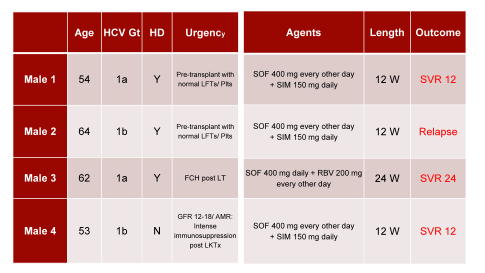
AASLD: The Pharmacokinetics and Safety of the Direct Acting Antiviral Regimen of ABT-450/r, Ombitasvir with/without Dasabuvir in Subjects with Mild, Moderate and Severe Renal Impairment Compared to Subjects with Normal Renal Function - (11/14/14)
AASLD: Urgent Treatment With Sofosbuvir Based Regimen For Hepatitis C Genotype 1 Patients With Severe Renal Insufficiency (GFR <30ml/min) - (12/03/14)
AASLD: Safety, Antiviral Efficacy, and Pharmacokinetics of Sofosbuvir in Patients With Severe Renal Impairment - (12/03/14)
Treatment in special patient populations: HIV/HCV coinfection
HIV/HCV coinfected infected individuals are no longer regarded a special patient population by major guidelines (EACS, EASL) but rather indication and drug choice follows the general guidelines for HCV monoinfected subjects.
Nevertheless, it is reassuring to see results from various IFN-free DAA trials once again highlighting the comparable high SVR rates as observed for similar regimens in monoinfected patients. Among the different studies presented were the combined analyses from the PHOTON-1 and 2 trials which studied the combination of sofosbuvir and ribavirin in a whole range of different genotypes and durations in treatment-naïve and experienced patients (14). Figure 19 shows the various study arms examined in this to date largest IFN-free DAA study in coinfection.
Figure 19: Study design of PHOTON-1 and 2
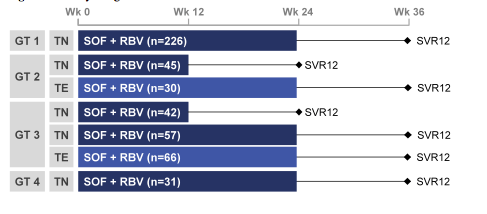
Broad inclusion criteria were applied within the trial permitting the inclusion of compensated cirrhosis. There was also no platelet cutoff. A wide range of antiretrovirals was allowed with undetectable HIV RNA for >8 weeks on stable ART regimen; baseline CD4 count in ART treated had to be >200 cells/μL and in ART untreated > 500 cells/μL. The efficacy results for GT 1,2 and 4 are shown in figure 20.
Figure 20: SVR12 for HCV genotype 1, 2 and 4 GT 1-4 HIV-HCV (PHOTON-1 and 2)
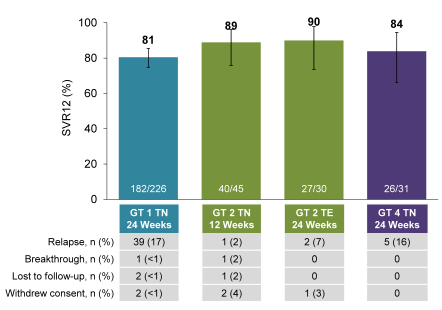
Clearly, the overall SVR rates are quite impressive but the relative high relapse rate in GT1 and 4 patients also suggests that dual DAA combinations are to be favored for these genotypes. For GT2 however, the sofosbuvir + ribavirin combination already seems to be the solution for almost all patients and underlines why this has become the gold standard for therapy of genotype patients altogether. The results for treatment of the GT3 patients is shown below in figure 21.
Figure 21: SVR12 for HCV genotype 3
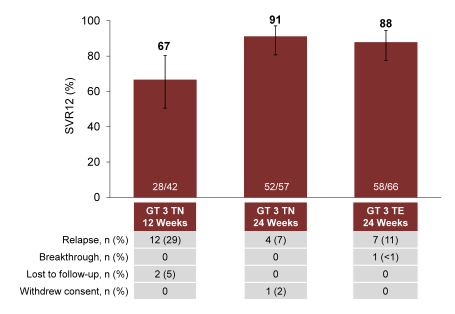
Obviously the extension of treatment duration made a huge difference in the SVR rates observed. 12 weeks are simply too short for this combination for therapy of genotype 3 patients. The cure rates for 24 weeks however, and this is true for naïve as well as treatment experienced patients are surprisingly high and make this an alternative treatment option particularly for non-cirrhotic treatment naïve genotype 3 patients. Additional subanalysis showed that SVR rates were lower for GT1 and 3 patients in the presence of cirrhosis again suggesting that more potent strategies are needed for these more challenging to treat patient groups. Safety in this large trial overall was excellent with only 8% of patients developing a Grade 3 or 4 AE and only 2.5% had an adverse event resulting in early SOF discontinuation. There was no change in CD4 T-cell percentage during treatment. Among patients suppressed on ART, 1% had HIV virologic breakthrough though none of these subjects required a change in ART.
AASLD: Sofosbuvir and Ribavirin Therapy for the Treatment of HIV/HCV Coinfected Patients With HCV GT 1-4 Infection: The PHOTON-1 and -2 Trials - (11/12/14)
The next interesting coinfection presentation was the final analysis of the NIAID ERADICATE study (15). In this pilot trial 50 HCV, genotype-1, treatment naïve subjects received a fixed dose combination (FDC) of SOF/LDV (400mg/90mg) once daily for 12 weeks in two different groups (A: antiretroviral therapy (ARV)-naïve, n=13 and B: patients on permitted ARV combination comprised of the following: Truvada with Efavirenz, Rilpivirine or Raltegrevir with HIV viral suppression, n=37). The study design is depicted below in figure 22.
Figure 22: Study design of the ERADICATE study

Overall excellent SVR rates were obtained but remember that no cirrhotics or previous treatment failures were included into this pilot trial.
Figure 23: SVR rates under SOF/LDV in TN GT 1 HIV/HCV co-infected patients
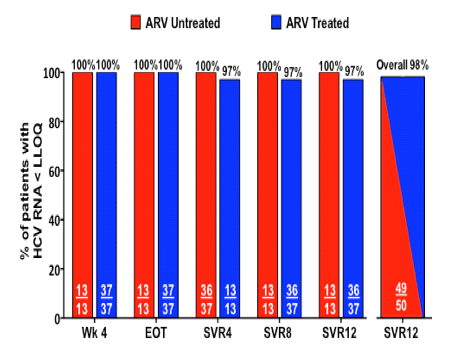
There were no changes in CD4 counts, HIV RNA levels or renal parameters observed. There were no serious adverse events (SAEs) related to study drugs or discontinuations due to adverse events.
AASLD: Use of Ledipasvir/Sofosbuvir Fixed Dose Combination for Treatment of HCV Genotype-1 Infection in Patients Coinfected with HIV - (11/10/14)
Another coinfection trial presented at AASLD was the TURQUOISE-1 trial (16). TURQUOISE-I is a randomized, open-label study evaluating the 3D+RBV regimen for 12 or 24 weeks. HCV treatment-naïve or pegIFN/RBV-experienced patients, with or without Child-Pugh A cirrhosis, CD4+ count ≥200 cells/mm3 or CD4+ % ≥14%, and plasma HIV-1 RNA suppressed on a stable atazanavir- or raltegravir-inclusive antiretroviral (ART) regimen were included. The study design is shown in figure 24.
Figure 24: Study design of the TURQUOISE-1 study
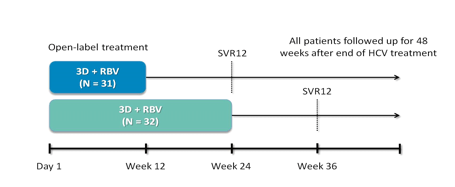
12/63 patients had cirrhosis at baseline and 21/63 were treatment experienced. So overall this was already somewhat more challenging patient population. SVR rates were however, very high (>93%) and showed no difference between 12 or 24 weeks of therapy indicating that 12 weeks of this DAA combination therapy will be sufficient. The EOT and SVR rates are shown below in figure 25.
Figure 25: EOT and SVR rates from the TURQUOISE-1 trial
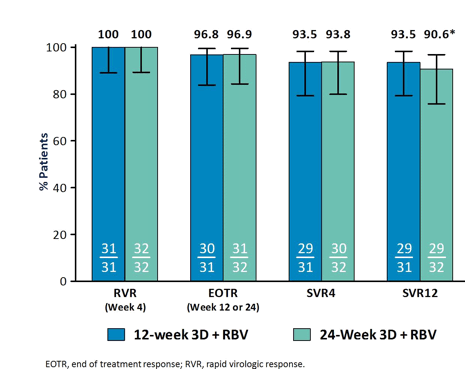
In the 3D combination trial + ribavirin in HIV/HCV coinfection 2 HCV reinfections occurred after achieving successful end-of-treatment (explaining the decrease above from 93.8% between SVR4 and SVR12 to 90.6% in the 24 weeks arm) reminding us all that even though HCV may be cured much more easy these days reinfection with HCV can occur at any time if risk behavior leading to HCV transmission is not changed. The overall safety profile of this DAA regimen was very good, adverse events were generally mild, and no serious adverse events or discontinuations due to an adverse event were reported. The most common adverse events were fatigue, insomnia, and nausea. Elevation in total bilirubin was the most common laboratory abnormality, occurring predominantly in pts receiving atazanavir/r.
AASLD: TURQUOISE-I: 94% SVR12 in HCV/HIV-1 Co-infected Patients Treated With ABT-450/r/Ombitasvir and Dasabuvir and Ribavirin - (11/12/14)
The last study of great interest including HIV patients was the C-WORTHY trial which assessed efficacy, safety and durability of response of (Grazoprevir former MK-5172 (HCV NS3/4A protease inhibitor) and Elbasvir former MK-8742 (HCV NS5A replication complex inhibitor) ± ribavirin (RBV) in treatment-naive (TN), non-cirrhotic genotype (GT) 1 HCV mono-infected and HIV/HCV co-infected patients (pts) (17). The study design is depicted below in figure 26. C-WORTHY enrolled 159 mono-infected and 59 co-infected pts. Mono-infected pts received 8 or 12 weeks of MK-5172 (100 mg QD) + MK-8742 (20 or 50 mg QD) ± RBV. Co-infected pts received 12 weeks ± RBV; all were on stable anti-retroviral regimens (raltegravir + tenofovir or abacavir with 3TC or FTC).
Figure 26: Study design of the C-WORTHY trial
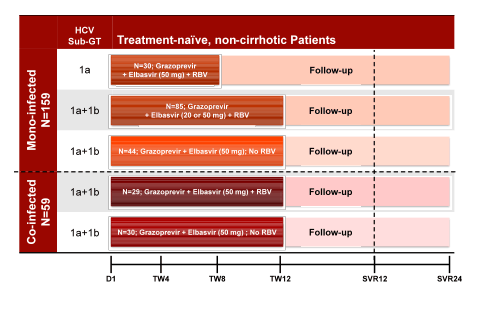
Once again HCV treatment outcome was comparable between mono- and coinfected subjects. The main efficacy results are shown below in figure 27.
Figure 27: Efficacy outcome of the C-WORTHY trial
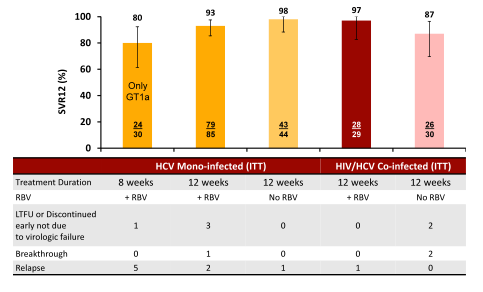
The safety profile of MK-5172 + MK-8742 ±RBV was similar in mono- and co-infected pts. No patient discontinued due to an adverse event (AE) or laboratory abnormality. The most common AEs were fatigue, headache, nausea, insomnia and asthenia. Co-infected pts maintained HIV suppression during therapy except for 1 who discontinued HIV medications.
In a second presentation by Lawitz et al the same combination Grazoprevir + Elbasvir +/- ribavirin was evaluated in patients with prior PR null response ± cirrhosis or treatment-naive patients with cirrhosis (18). Patients were randomized to receive Grazoprevir (100 mg QD) and Elbasvir (50 mg QD) ± ribavirin (weight-based) for 12 or 18 weeks. The efficacy results for this more liver disease advanced patient population are shown in figure 28. Overall, cure rates were ≥94% regardless whether patients were treated for 12 or 18 weeks and independent of additional ribavirin therapy. Noteworthy is that this is one of the first DAA trials evaluating 18 weeks rather than 24 weeks as a treatment duration extension. The authors concluded that the novel combination of Grazoprevir + Elbasvir +/- ribavirin demonstrated high rates of efficacy in treatment-naïve patients with cirrhosis and prior PR null responders. Neither RBV nor extension of treatment duration from 12 to 18 weeks was needed to achieve SVR12 in a high proportion of patients. These results support the ongoing Phase 3 development of Grazoprevir + Elbasvir ± ribavirin for 12 weeks.
AASLD: Efficacy and safety of MK-5172 + MK-8742± ribavirin in HCV mono-infected and HIV/HCV co-infected treatment-naïve, non-cirrhotic patients with hCV gT1 infection: The C-WORTHY study (Final results, Parts A and B) - (11/12/14)
Figure 28: C-Worthy: Cirrhotic Patient Primary Efficacy results
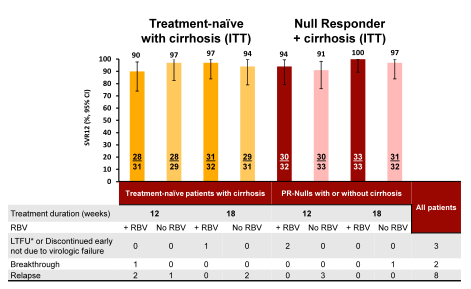
AASLD: Efficacy and safety of MK-5172 and MK-8742 ± RIBAVIRIN IN Hcv Gt1 Infected Patients with cirrhosis or previous null reSPonse: FINAL RESULTS OF the C-WORTHY Study (PARTS A AND B) - (11/12/14)
Treatment in special patient populations: Genotype 3 patients
HCV therapy in genotype 3 infected HCV patients has emerged as a particularly difficult to treat HCV genotype. Not all of the newly available DAAs have activity against genotype 3 further limiting treatment choices in this patient group. At AASLD highly interesting data on treatment of genotype 3 infection has emerged for the combination of sofosbuvir with the NS5A inhibitors daclatasvir as well as ledipasvir which were eagerly awaited as questions with regard to activity of these combinations, necessary treatment duration and the role of ribavirin in these combinations were still unanswered. Also although sofosbuvir + ribavirin combination led to quite high treatment success rates this was in the context of quite costly 24 weeks of therapy. In addition more potent agents were needed for the more challenging to treat subset of patients with cirrhosis and previous non-response.
The first large study to report on is the phase III ALLY-3 study (19). In Ally-3 the efficacy and safety of the combination of daclatasvir (DCV) (potent, pangenotypic NS5A inhibitor) and sofosbuvir (SOF) (NS5B polymerase inhibitor) for 12 weeks were evaluated in patients chronically infected with GT 3. Two cohorts consisting of treatment-naive or -experienced (prior treatment failures, including prior SOF- or alisporivir-treated) patients received open-label DCV 60 mg + SOF 400 mg QD for 12 weeks. The corresponding study design is shown below in figure 29.
Figure 29: Study design of the ALLY-3 trial
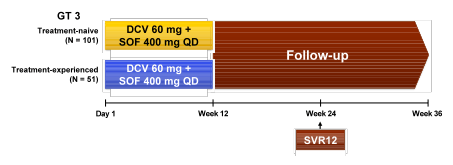
152 patients were treated: 101 (66%) treatment-naive and 51 (34%) treatment-experienced; 21% were cirrhotic, 61% non-CC IL28B genotype, 71% HCV RNA ≥800K IU/mL. Baseline characteristics were comparable between the 2 cohorts except for a higher proportion of cirrhotic patients in the treatment-experienced cohort. Overall, 90% and 86% of treatment-naive and -experienced patients, respectively, achieved SVR12. SVR rates were significantly influenced by presence of cirrhosis as shown in figure 30. One patient had detectable HCV RNA at the end of treatment and 15 had relapse post-treatment (mostly cirrhotic patients). These findings clearly suggest that 12 weeks of daclatasvir + sofosbuvir are sufficient for treating non-cirrhotic patients. In cirrhotics and particularly those with previous treatment failure the longer duration of 24 weeks should be recommended. In how far addition of ribavirin could impact the relapse rate observed in this trial remains unclear as ribavirin was not studied in this trial. However, for cost reason this remains a very important question. Also for the very difficult to treat cirrhotic previous non-responder with GT3 infection one also wonders whether ribavirin even in 24 treatment duration could potentially help to improve SVR rates.
Figure 30: SVR12 in Patients with Cirrhosis. Results from ALLY-3
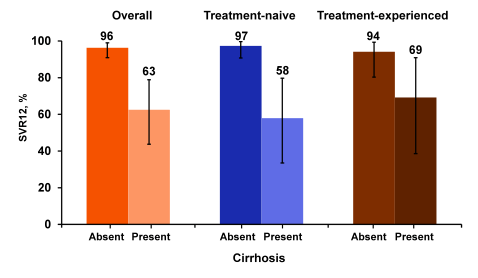
The IFN and ribavirin free combination was well tolerated and safe. One serious adverse event was reported on-treatment: a gastrointestinal bleed considered not related to study treatment. There were few Grade 3/4 laboratory abnormalities-observed only for platelets (n=2), lymphocytes (n=1), international normalized ratio (INR; n=2), and lipase (n=3); however these did not lead to treatment discontinuations. The most frequent adverse events (all grades) were headache (20%), fatigue (18%), nausea (12%), and diarrhea (9%).
New data on treatment of HCV genotype 3 also emerged for the Ledipasvir/Sofosbuvir fix-dose combination (20). Previously, at EASL data from the ELECTRON-2 trial in HCV genotype -3 treatment naïve individuals had been presented showing that among people taking sofosbuvir/ledipasvir alone, 64% achieved sustained virological response after 12 weeks of post-treatment follow-up, while 8 relapsed (21). Among those taking sofosbuvir/ledipasvir plus ribavirin, however, the SVR12 rate was 100%. In this new presentation here at AASLD efficacy and safety results were presented from treatment-experienced GT-3 patients (group 1), including those with cirrhosis again receiving the Ledipasvir/Sofosbuvir + ribavirin combination. The study also evaluated whether LDV/SOF without RBV would be effective in treatment-naïve (TN) and treatment experienced (TE) patients with HCV genotype 6 (group 2). Study results are presented below in figure 31. Overall results were 82% SVR12 rate for the GT3 patients receiving Ledipasvir/Sofosbuvir + ribavirin. SVR rate decreased however in the presence of cirrhosis at baseline suggesting that either more potent regimens or longer treatment durations may be needed in this more challenging to treat patient group. In patients with HCV genotype 6 infection, LDV/SOF for 12 weeks without RBV provides the first reported safe and effective all oral regimen with impressive high cure rates of 96%.
Figure 31: SVR results in genotype 3 and 6 patients from the ELECTRON-2 trial
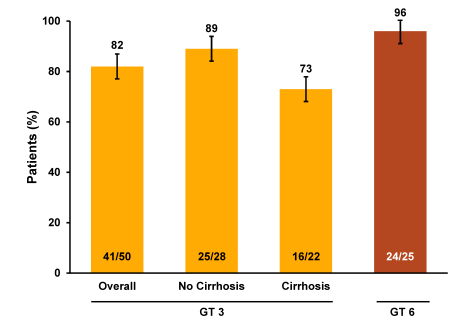
Treatment in special patient populations: previous sofosbuvir failures
Although SVR rates under modern DAA based therapy are without any question impressive and a triumph of drug development in general one should not forget that the number of patients failing DAA based therapy is increasing prompting the question what treatment strategies may be employed in these patients. Interesting data was presented from patients who had failed previous SOF-based therapies in whom the efficacy of 12 weeks of LDV/SOF+RBV was evaluated (22). Genotype 1 HCV infected patients who participated in a prior SOF Phase 2/3 study (49% had received SOF+PEG-IFN+RBV and 41% SOF+RBV) and failed to achieve SVR12, were enrolled. The primary endpoint was SVR12. At end-of-treatment 51/51 (100%) had HCV RNA < LLOQ and 50/51 (98%) had HCV RNA < LLOQ at SVR12. The one single patient with failure was found to be infected with HCV genotype 3 - previously treated with SOF/RBV for 24 weeks. These data underline that in patients with relapse after sofosbuvir based therapy a re-exposure with sofosbuvir + a further DAA can be a very successful treatment strategy.
AASLD: All-Oral 12-Week Combination Treatment With Daclatasvir and Sofosbuvir in Patients Infected With HCV Genotype 3: ALLY-3 Phase 3 Study - (11/11/14)
AASLD: High Efficacy of LDV/SOF Regimens for 12 Weeks for Patients With HCV Genotype 3 or 6 Infection - (11/12/14)
AASLD: Retreatment of Patients Who Failed Prior Sofosbuvir-Based Regimens With All Oral Fixed-Dose Combination Ledipasvir/Sofosbuvir Plus Ribavirin for 12 Weeks> - (11/20/14)
Strategy questions in HCV therapy
What is the role of ribavirin in DAA therapy?
Obviously ever since IFN-free regimens have become an immediate reality the wish has developed to get rid of ribavirin as well. Although adverse event profiles have improved dramatically with the absence of IFN, side effects in ribavirin based therapies have remained in particular anemia which in patients with advanced liver disease requires quite intensive monitoring and often EPO or blood transfusion support which is quite costly. Colombo and colleagues presented data from a combined analysis of HCV genotype 1b patients treated in the PEARL-II, PEARL-III, SAPPHIRE-I, SAPPHIRE-II or TURQUOISE-II trials receiving 12 or 24 weeks of coformulated ombitasvir/ABT-450/r and dasabuvir with or without weight-based RBV (23). Overall, 992 patients infected with HCV GT1b were enrolled. The very high response rates obtained in these studies are shown below in figure 32. No patient receiving 3D alone experienced virologic failure or relapse by post-treatment wk 12; on-treatment failure or relapse occurred in 0.1% (1/691) and 0.6% (4/684) of patients receiving 3D+RBV, respectively. Serious AEs occurred in 2.3% (23/995) of patients overall; 0.5% (5/995) discontinued due to AEs, all of whom received 3D+RBV.
Figure 32: 3D SVR Rate for Patients with HCV Genotype 1b Infection

These results clearly underline that in genotype 1b patients there is no need for additional ribavirin therapy. But what about the more difficult-to-treat genotype 1-a patients? Everson et al presented pooled data from four phase 3 clinical trials (PEARL-IV, SAPPHIRE-I, SAPPHIRE-II, or TURQUOISE-II trials) assessing the SVR12 rates of the 3D regimen with or without ribavirin (RBV) in treatment-naïve and prior pegIFN/RBV (PR)-experienced pts with or without cirrhosis infected with HCV GT1a (24). Overall 1060 HCV GT1a-infected patients were included. 12 weeks of 3D+RBV yielded similarly high SVR12 rates in treatment naïve and PR-experienced groups (see figure 33). SVR12 rates were higher in treatment naive patients without cirrhosis receiving 3D+RBV (96%) compared to 3D alone (90.2%). In additional multivariate analysis patients from both treatment groups (3D and 3D + RBV) were pooled. 2/12 variables assessed were statistically significantly associated
with lower SVR12 rates: BMI (p=0.005) and treatment regimen (3D + RBV versus 3D) (p=0.007). The odds ratio for baseline BMI was 0.90, 95% CI (0.84, 0.97). High SVR12 rates were observed with both 12 and 24 week treatments in patients with cirrhosis, however, in GT1a-infected pts with cirrhosis and a prior PR null response a higher SVR12 rate was observed with longer treatment duration.
Figure 33: SVR12 in GT1a-Infected Patients
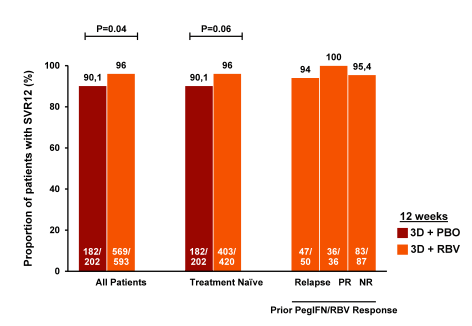
In summary, treatment-naïve patients without cirrhosis the addition of RBV to 3D improved SVR12 rates. GT1a-infected patients with cirrhosis and a prior PR null response may benefit from longer treatment duration.
Additional data on the impact of baseline characteristics as well as treatment duration derive from a new analysis from the TURQUOISE-II study (25). The phase 3 TURQUOISE-II trial examined efficacy and safety of an all-oral regimen of co-formulated ABT-450/r/ombitasvir+dasabuvir with ribavirin (3D+RBV) in treatment (tx)-naïve and tx-experienced pts with HCV genotype (GT) 1 infection and compensated (Child-Pugh A) cirrhosis. The efficacy outcome from the original TURQUOISE-II Study presentation at EASL 2014 for GT1a is shown below in figure 34. Overall, 380 pts were randomized and received study drug. In this AASLD analysis, overall SVR12 rates were 91.8% and 96.5% for the 12-
and 24-week arms, respectively. SVR12 rates did not differ substantially by sex, age, body-mass index, or HCV RNA. SVR12 rates were 88.9-97.0% in pts with platelet counts <100x109/L and 84.0-88.9% in pts with serum albumin <35g/L. An extension of treatment duration at least in cirrhotic previous non-responders appears useful. Patients with advanced portal hypertension just like in other trials seem to respond less favorably.
Figure 34: SVR12 Rates with 3D + RBV in GT1a Treatment-Naïve and -Experienced Patients with Cirrhosis
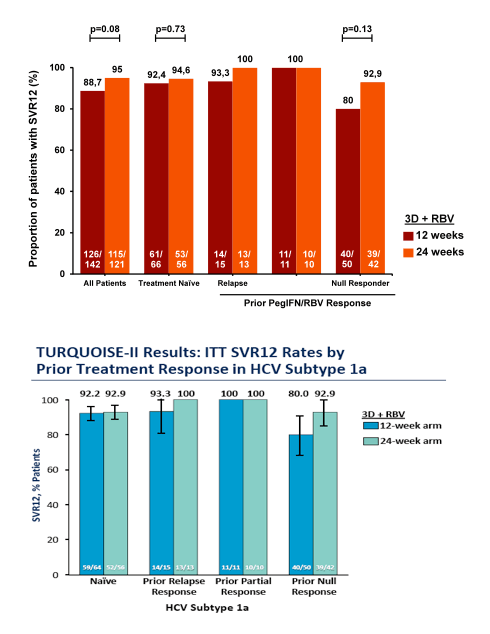
In an additional multivariate analysis IL28B TT genotype, prior null response, region (North America versus Europe) and history of intravenous drug use all were significantly associated with a decrease in HCV cure rates.
AASLD: SVR12 Rate of 98.6% in 992 HCV Genotype 1b-Infected Patients Treated With ABT-450/r/Ombitasvir and Dasabuvir With or Without Ribavirin - (12/01/14)
AASLD: INTEGRATED EFFICACY ANALYSIS OF FOUR PHASE 3 STUDIES IN HCV GENOTYPE 1A-INFECTED PATIENTS TREATED WITH ABT-450/R/OMBITASVIR AND DASABUVIR WITH OR WITHOUT RIBAVIRIN - (11/10/14)
AASLD: TURQUOISE-II: REGIMENS OF ABT-450/r/OMBITASVIR AND DASABUVIR WITH RIBAVIRIN ACHIEVE HIGH SVR12 RATES IN HCV GENOTYPE 1-INFECTED PATIENTS WITH CIRRHOSIS, REGARDLESS OF BASELINE CHARACTERISTICS - (11/10/14)
Which impact does early virological suppression have on treatment outcome and possibly duration?
One important question in clinical practice is whether the time point of first complete HCV RNA negativation plays a role in predicting treatment response or can potentially allow to individualize treatment duration which obviously cost wise would be highly desirable. Mark Sulkowski presented an interesting study in that context which assessed whether time of first viral suppression of HCV RNA measurement < lower limit of quantification [LLOQ]) in cirrhotic and non-cirrhotic patients was associated with achievement of SVR12 (26). As one can see in figure 35 SVR12 rates were high regardless of time of initial suppression, ranging from 94-99% for cirrhotic patients and 98-99% for non-cirrhotic individuals. Unfortunately, this implies that in clinical practice in the DAA era (in contrast to the historic IFN-based HCV therapies) value of certain well defined time points for HCV viral load measurement do not exist.
Figure 35: 3D with or without RBV: SVR by Time to HCV RNA < 15 IU/mL
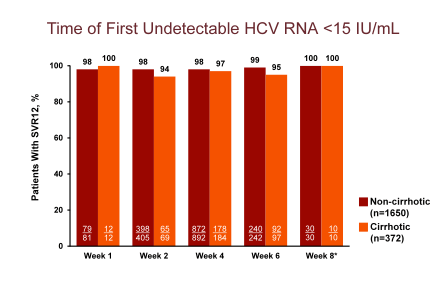
AASLD: Time to Viral Suppression [week 2/4] Is Not Related to Achievement of SVR12 in HCV GT1-infected Patients Treated With ABT-450/Ritonavir/Ombitasvir and Dasabuvir With or Without Ribavirin - (12/09/14)
AASLD: On-Treatment HCV RNA as a Predictor of Virologic Response in the Ledipasvir/Sofosbuvir Phase 3 Program for HCV Genotype 1 Infection: Analysis of the ION-1, ION-2, and ION-3 Studies - (12/09/14)
Is there a difference between SVR4, SVR12 or SVR24?
In an attempt to shorten HCV treatment trials SVR24 has moved down in many studies to report SVR as either SVR4 or SVR12 result. Is this safe and can the results for the various SVR time points be regarded as concordant? An interesting study on this subject was presented by Bernstein et al. (27). The endpoint of SVR12 as a reliable assessment of HCV eradication was validated as a reliable endpoint in the registrational Phase 3 ION-1, ION-2, and ION-3 trials including 1952 patients. HCV RNA concentrations were evaluated post-treatment to assess rates of SVR4, SVR12, and SVR24. Analyses were performed to assess the concordance between these assessments. 1902 patients had assessments available at post-treatment Weeks 4 and 12, 1853 patients at post-treatment weeks 12 and 24. Thirty-six (36) patients' relapsed (2%) and 2 patients were on-treatment, non-compliant virologic failures. Majority of patient who relapsed (78%) had detectable HCV RNA (>25 IU/mL) at post-treatment week 4 with the remaining 8 patients (22%) relapsed between week 4 and 12 post-treatment. No patients relapsed between post-treatment weeks 12 and 24. The corresponding predictive and negative values are depicted in figure 36. As no relapse occurred beyond week 12 post-treatment SVR 12 obtains 100% positive value making this an appropriate time point for the reliable assessment of a durable treatment response to LDV/SOF. SVR4 however, although having a very high prediction value of >99% still does not have the same certainty as SVR 12 or 24.
Figure 36: LDV/SOF Phase 3 Trials - Concordance SVR4, SVR12 and SVR24
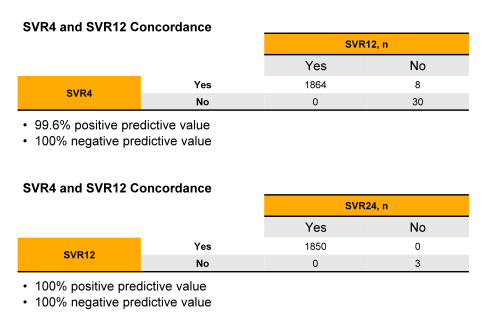
How short can successful HCV therapy possibly be?
Another important question is obviously whether there is a minimum time of successful HCV suppression needed for achieving HCV cure? If this is a function of potency of the agents combined, time to becoming undetectable and the presence of high genetic barrier, shorter treatment durations at least appear possible. In this context an interesting study was presented which looked at various treatment durations all the way down to only 4 weeks of therapy (28). The C-SWIFT study assessed the efficacy and safety of grazoprevir former MK-5172 (NS3/4A protease inhibitor) and elbasvir former MK-8742 (NS5A inhibitor) and sofosbuvir (nucleotide NS5B polymerase inhibitor) in treatment-naive patients with hepatitis C virus (HCV) genotype 1 (G1) infection for shortened durations of 4, 6, or 8 weeks. The study design is shown below in figure 37.
Figure 37: C-Swift: Study Design: All treatment arms: Grazoprevir 100mg QD / Elbasvir 50mg QD FDC Sofosbuvir 400mg QD
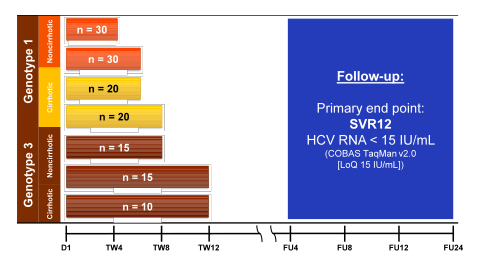
The virological response rates are shown below in figure 38.
Figure 38: Primary Efficacy Results (Interim analysis: SVR4/8, Modified Intent To Treat Analysis)
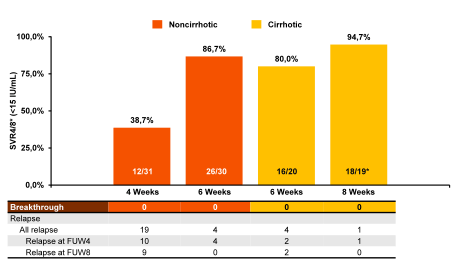
Clearly, this interim analysis suggests that 4 weeks are not sufficient for eradicating HCV from the majority of patients. 6 weeks already looks much better but still has some relapses prompting the question whether in the future the HCV field will be able to identify predictors of response which would reliably allow to chooses shorter treatment durations in more easy to treat patients.
AASLD: C-SWIFT: Grazoprevir (MK-5172) + Elbasvir (MK-8742) + Sofosbuvir in Treatment-Naive Patients With Hepatitis C Virus Genotype 1 Infection, With and Without Cirrhosis, for Durations of 4, 6, or 8 Weeks (Interim Results) - (11/10/14)
Any news from other future DAA combinations?
The development of DAAs is occurring at an unbelievable pace and cure rates have become difficult to improve. Nevertheless the HCV field is still eager for future combinations if not alone for the idea of treatment choices and competition which eventually may help to induce a decrease in HC treatment costs.
Two of the few phase III trials presented at AASLD were results from the UNITY-1 and 2 trials (29). The all-oral combination of daclatasvir (DCV; pan-genotypic NS5A inhibitor), asunaprevir (ASV; NS3 protease inhibitor), and BMS-791325 (non-nucleoside NS5B inhibitor)-DCV 3DAA regimen-was evaluated without ribavirin in HCV genotype (GT) 1-infected treatment-naive and -experienced patients without cirrhosis in a Phase 3, open-label, international clinical trial. Patients received a fixed-dose combination (FDC) of DCV 30 mg, ASV 200 mg, and BMS-791325 75 mg twice daily for 12 weeks. The study design is summarized below in figure 39.
Figure 39: Study design of UNITY-1

Baseline characteristics were comparable between the treatment-naive (N=312) and treatment-experienced (N=103) cohorts. Overall, patients were 58% male and 26% IL28B (rs1297860) CC genotype; 73% were infected with GT 1a and 27% with GT 1b. One death reported post-treatment was considered not related to study treatment. There were 7 serious adverse events, all considered unrelated to study treatment, and 3 (<1%) adverse events leading to treatment discontinuation. The most common adverse events (in >10% of patients) were headache, fatigue, diarrhea, and nausea. The efficacy results are shown in figure 40.
Figure 40: Unity-1: SVR12 Rates (mITT)

Overall, high SVR rates were obtained for the DCV 3 DAA combination without ribavirin after 12 weeks of therapy in the naïve and experienced group likewise. 2% of patients in the naïve as well as in the treatment experienced patient group experienced virological breakthrough, relapses occurred in 5 and 6% of patients, respectively. These findings demonstrate potent antiviral activity, safety, and tolerability of the DCV 3DAA regimen in treatment-naïve and treatment experienced GT 1 patients without cirrhosis.
Now how does this new combination perform in more difficult patient groups such as with cirrhosis? In UNITY-2 the all-oral combination of daclatasvir (DCV; pan-genotypic NS5A inhibitor), asunaprevir (ASV; NS3 protease inhibitor), and BMS-791325 ('325; non-nucleoside NS5B inhibitor)-DCV 3DAA regimen-was studied with and without ribavirin (RBV) in treatment-naive and treatment-experienced patients with HCV genotype 1 infection and compensated cirrhosis in a Phase 3, international clinical trial (30). Patients were randomly assigned to receive a fixed-dose combination (FDC) of DCV 30 mg, ASV 200 mg, and '325 75 mg, with blinded RBV or placebo, twice-daily for 12 weeks. The study design is summarized in figure 39.
Figure 41: Study design of the UNITY-2 trial.
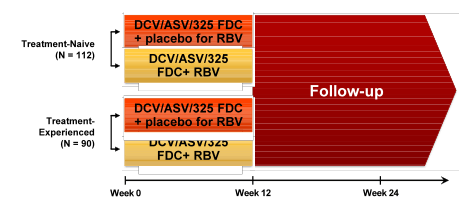
Overall, patients were 66% male and 27% IL28B (rs1297860) CC genotype; 74% of patients had GT1a infection and 26% had GT1b. There were 3 serious adverse events (SAEs) considered related to treatment, 1 AE leading to 3DAA discontinuation, and no deaths. The most frequent AEs (>10% of patients) were fatigue, headache, nausea, diarrhea, insomnia and pruritus. Hemoglobin <9 g/dL on treatment was observed in 5% of patients in the RBV-containing cohorts but in no patients in the RBV-free cohorts. The SVR12 rates for the different arms and patient populations are shown below in figure 42.
Figure 42: Unity-2: Virologic Efficacy
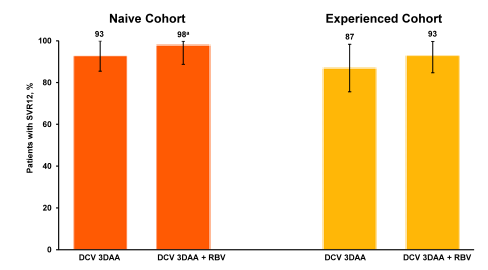
The all-oral treatment with DCV/ASV/BMS-791325 FDC achieved high SVR12 rates in all groups studied. However, numerically response rates were always some small percentage higher in the arms receiving additional ribavirin.
AASLD: All-Oral Fixed-Dose Combination Therapy With Daclatasvir/Asunaprevir/Beclabuvir, ±Ribavirin, for Patients With Chronic HCV Genotype 1 Infection and Compensated Cirrhosis: UNITY-2 Phase 3 SVR12 Results - (11/11/14)
AASLD: All-Oral, Fixed-Dose Combination Therapy With Daclatasvir/Asunaprevir/Beclabuvir for Non-Cirrhotic Patients With Chronic HCV Genotype 1 Infection: UNITY-1 Phase 3 SVR12 Results - (11/12/14)
Another new DAA combination presented in phase II was the combination of sofosbuvir with GS-5816 an investigational inhibitor of the HCV NS5A protein with picomolar antiviral activity across all HCV genotypes 1-6 (31). The current study evaluated whether this regimen would be effective for patients with HCV genotype 3 when administered for a shorter, 8-week duration (see figure 43). Overall two doses of GS-5816 ± ribavirin were evaluated.
Figure 43: Study design
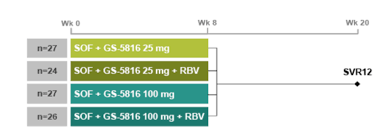
The SVR12 rates for the different arms are shown below in figure 44. Two patients did not complete the study treatment: one discontinued due to an adverse event, and one withdrew consent. Both withdrew before completing two weeks of treatment, prior to achieving undetectable HCV RNA, and were lost to follow-up in the post-treatment phase. Treatment with SOF+GS-5816 25 mg or 100 mg for 8 weeks, with or without RBV, resulted in high rates of SVR12 in GT3 HCV-infected patients. Treatment was well tolerated with no identified safety signal due to SOF or GS-5816.
Figure 44: SVR12 rates
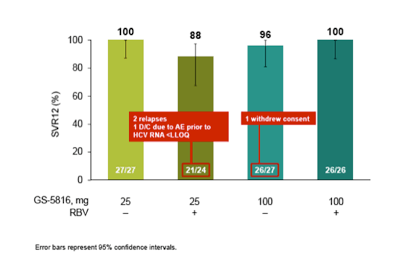
As the only few relapses occurred in the lower GS-5816 treatment arm the question does arise whether it would be better to move forward with the higher dose of 100mg in the subsequent phase III program. Altogether, the high SVR rate after only 8 weeks however does potentially promise shorter treatment durations for genotype 3 in the future at least for non-cirrhotic patients.
In addition the final results from a Phase 2 study including evaluation of SOF + GS-5816 ± RBV for 8 weeks in treatment naïve patients without cirrhosis with genotype 1-6 HCV infection were reported (32). In Part A of this study, treatment naïve genotype 1-6 HCV-infected patients without cirrhosis were randomized 1:1 to SOF+GS-5816 25mg or SOF+GS-5816 100mg for 12 weeks. In Part B, treatment naïve genotype 1 and 2 HCV-infected patients without cirrhosis were randomized 1:1:1:1 to SOF+ GS-5816 25mg, SOF+GS-5816 25mg+RBV, SOF+GS-5816 100mg or SOF+GS-5816 100 mg + RBV for 8 weeks. The SOF dose was 400 mg. Ribavirin was administered 1000-1200mg in a divided daily dose. The study design is shown below in figure 45.
Figure 45: Study design
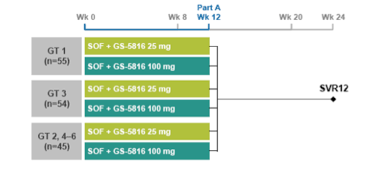
377 patients (47% GT1, 33% GT2, 14% GT3, 4% GT4, < 1% GT5, and 2% GT6) were randomized and treated; 58% were male, 87% were white, and 36% had IL28B CC genotype. HCV RNA results at post-treatment week 12 (SVR12) for part A are presented below in figure 46a and 46b.
Figure 46a: SVR12 for GT1, GT2 and GT3
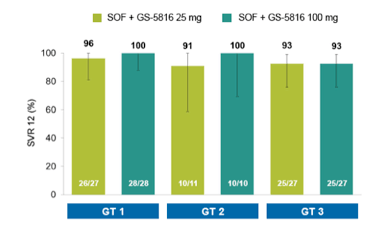
Figure 46b: SVR12 for GT4, GT5 and GT6

SVR rates ranged from 91-100% with 12 weeks of treatment. Part B then looked at the same combinations and dosages but in shortened treatment durations of 8 weeks. SVR rates ranged from 77-90% with 8 weeks of treatment and were thereby somewhat lower than the 12 week duration. Relapse accounted for all virologic failures with the majority of relapse occurring by post-treatment week 4. RBV did not appear to enhance SVR rates. This first data is clearly encouraging but does show a decrease in SVR12 with shorter duration raising the question which dose and duration may be best particularly in more challenging to treat patients with cirrhosis and previous non-response. The presenters of this work conclude that co-administration of SOF with GS-5816 100mg for 12 weeks without RBV is an appropriate regimen for further evaluation in Phase 3 studies. This was also supported from results of the same combination in a phase 2 study evaluating SOF + GS-5816 ± RBV for 12 weeks in treatment experienced patients with genotype 1 or 3 HCV infection with or without cirrhosis (33). SOF + GS-5816 for 12 weeks resulted in high SVR12 rates in treatment experienced GT 1 or GT 3 patients including those with cirrhosis. In GT 3 however, SVR rates were higher with SOF + GS-5816 100mg compared with SOF + GS-5816 25mg. RBV did not increase the SVR rates when co-administered with the 100mg dose of GS-5816, but was associated with more toxicity than observed in the ribavirin free study arms.
AASLD: High Efficacy of LDV/SOF Regimens for 12 Weeks for Patients With HCV Genotype 3 or 6 Infection - (11/11/14)
AASLD: Once-Daily Sofosbuvir With GS-5816 for 8 Weeks With or Without Ribavirin in Patients With HCV Genotype 3 Without Cirrhosis Result in High Rates of SVR12: The ELECTRON-2 Study - (11/10/14)
AASLD: Safety and Efficacy of Treatment with Sofosbuvir + GS-5816 ± Ribavirin for 8 or 12 Weeks in Treatment-Naïve Patients with Genotype 1-6 HCV Infection - (11/10/14)
Summary
· HCV cure rates in clinical practice remain high and suggest that even in real-life patients the high HCV SVR rates (>90%) are reproducible but on average there is a 5% lower cure rate also indicating that there is a growing number of patients who have now failed under DAA-based therapy which will require more potent treatment options in the near future. This is particularly true for the more challenging patient populations as the cirrhotic genotype 1 patient with a history of previous HCV treatment failure.
· The safety profile of Sofosbuvir/Simeprevir +/- RBV in real-life cohorts is very favourable. Indeed overall treatment discontinuation rates were extremely low with only 5%, hereof non-adherence 3% and adverse events only 1.9%.
· Quite dramatic clinical improvement of patients with very advanced stages of liver cirrhosis can be observed under successful HCV therapy, which can be documented by an improvement in MELD score as well as an increase in serum albumin indicative of an improvement of liver synthesis function.
· Findings from trials evaluating the Ledipasvir/Sofosbuvir fix-dose combination with or without ribavirin in compensated cirrhosis suggest that there is a role for ribavirin in the more difficult-to-treat treatment experienced cirrhotic patients which would allow going for shorter treatment duration of 12 weeks which could implicate quite some cost savings. Extending treatment duration to 24 weeks for LDV/SOF also increased response rates in the cirrhotic treatment experienced patient group to 98%.
· Various IFN-free DAA combination trials were presented for treatment of recurrent HCV in patients after liver transplantation demonstrating high SVR12 rates, thereby reassuring the field once again that IFN-free treatment options are also emerging for this particularly challenging patient group.
· In patients with chronic HCV GT1 or 3 with creatinine clearance (CrCl) less than 30mL/min as calculated by the Cockcroft-Gault equation SOF 200mg + RBV 200mg daily for 24 weeks or sofosbuvir 400mg every other day and simeprevir 150mg daily have been reported from case series to be safe and efficacious.
· Outcome of DAA based therapies in HIV/HCV coinfected patients are comparable to the HCV cure rates in HCV mono-infection.
· In the 3D combination trial + ribavirin in HIV/HCV coinfection 2 HCV reinfections occurred after achieving successful end-of-treatment reminding us all that even though HCV may be cured much more easy these days reinfection with HCV can occur at any time if risk behaviour leading to HCV transmission is not changed.
· The novel combination of Grazoprevir + Elbasvir ± ribavirin demonstrated high rates of efficacy in treatment-naïve patients with cirrhosis and prior PR null responders. Neither RBV nor extension of treatment duration from 12 to 18 weeks was needed to achieve SVR12 in a high proportion of patients. These results support the ongoing Phase 3 development of Grazoprevir + Elbasvir ± ribavirin for 12 weeks.
· In the ALLY-3 trial 12 weeks of daclatasvir + sofosbuvir was sufficient for treating non-cirrhotic HCV genotype 3 patients. In cirrhotics and particularly those with previous treatment failure the longer duration of 24 weeks should be recommended. In how far addition of ribavirin could impact the relapse rate observed in this trial remains unclear as ribavirin was not studied in this study.
· In patients with HCV genotype 6 infection, LDV/SOF for 12 weeks without RBV provides the first reported safe and effective all oral regimen.
· The 12-wk 3D regimen with or without RBV achieved optimal efficacy in all HCV GT1b-infected patients, including historically difficult to cure subgroups with prior PR null response and/or cirrhosis. The addition of RBV to the 3D regimen did not provide additional benefit in patients without cirrhosis, nor did longer treatment duration in patients with cirrhosis treated with 3D+RBV. In contrast in treatment-naïve HCV GT1a patients without cirrhosis the addition of RBV to 3D improved SVR12 rates. GT1a-infected patients with cirrhosis and a prior PR null response may benefit from longer treatment duration
· In phase 3 trials of 3D±RBV, most patients achieved HCV RNA < LLOQ by week 2. Time to viral suppression was not associated with subsequent achievement of SVR12 in either cirrhotic or non-cirrhotic patients.
· In the C-SWIFT trial the highly potent, pangenotypic combination of grazoprevir former MK-5172 (NS3/4A protease inhibitor) and elbasvir former MK-8742 (NS5A inhibitor) and sofosbuvir in treatment-naive patients with hepatitis C virus was not able to achieve cure in more than 50% of patients after 4 weeks of therapy suggesting that there may be a minimum time of successful HCV suppression needed for obtaining SVR. 86.6/% of non-cirrhotic treatment naïve HCV patients however achieved SVR4 after 6 weeks of therapy.
· The UNITY-1 trial demonstrates potent antiviral activity, safety, and tolerability of the DCV 3DAA regimen in treatment-naïve and treatment experienced GT 1 patients without cirrhosis. In patients with cirrhosis the same combination with and without ribavirin was also very successful with small numeric increases in SVR12 rates in the ribavirin arms.
· Based on phase II dose finding studies co-administration of SOF with GS-5816 100mg for 12 weeks without RBV has been selected as an appropriate regimen for further evaluation in Phase 3 studies.
In summary, IFN-free combination therapy in real-life cohorts has demonstrated high HCV cure rates and good safety. However, ribavirin and longer treatment durations still seem to play a role at least in the more challenging cirrhotic previous treatment non-responders.
References
1. Fried MW: Hepatitis Debrief. 65th Annual Meeting of the American Association for the Study of Liver diseases, November 7-11, 2014, Boston, USA; Session: Hepatitis Debrief
2. Dieterich D et al.: Evaluation of sofosbuvir and simeprevir-based regimens in the TRIO network: academic and community treatment of a real-world, heterogeneous population. 65th Annual Meeting of the American Association for the Study of Liver diseases, November 7-11, 2014, Boston, USA; abstract 46
3. Jensen DM et al.: Safety and Efficacy of Sofosbuvir-Containing Regimens for Hepatitis C: Real-World Experience in a Diverse, Longitudinal Observational Cohort. 65th Annual Meeting of the American Association for the Study of Liver diseases, November 7-11, 2014, Boston, USA; abstract 45
4. Flamm SL et al.: Ledipasvir/Sofosbuvir with Ribavirin for the Treatment of HCV in Patients with Decompensated Cirrhosis: Preliminary Results of a Prospective, Multicenter Study. 65th Annual Meeting of the American Association for the Study of Liver diseases, November 7-11, 2014, Boston,USA; abstract 239
5. Bourliere M et al.: An Integrated Safety and Efficacy Analysis of >500 Patients with Compensated Cirrhosis Treated with Ledipasvir/Sofosbuvir with or without Ribavirin. 65th Annual Meeting of the American Association for the Study of Liver diseases, November 7-11, 2014, Boston, USA; abstract 82
6. Bourliere M et al.: Ledipasvir/Sofosbuvir Fixed Dose Combination is Safe and Efficacious in Cirrhotic Patients Who Have Previously Failed Protease-Inhibitor Based Triple Therapy. 65th Annual Meeting of the American Association for the Study of Liver diseases, November 7-11, 2014, Boston, USA; abstract LB-6
7. Mantry P e al.: High Sustained Virologic Response Rates in Liver Transplant Recipients With Recurrent HCV Genotype 1 Infection Receiving ABT-450/r/Ombitasvir+Dasabuvir Plus Ribavirin. 65th Annual Meeting of the American Association for the Study of Liver diseases, November 7-11, 2014, Boston, USA; abstract 198
8. Kwo PY et al.: An Interferon-free Antiviral Regimen for HCV after Liver Transplantation. N Engl J Med. 2014 Nov 11. [Epub ahead of print]
9. Reddy K et al.: Ledipasvir/Sofosbuvir with Ribavirin for the Treatment of HCV in Patients with Post Transplant Recurrence: Preliminary Results of a Prospective, Multicenter Study. 65th Annual Meeting of the American Association for the Study of Liver diseases, November 7-11, 2014, Boston, USA; abstract 8
10. Fontana R et al.: High efficacy and favorable safety profile of Daclatasvir based all oral antiviral therapy in liver Transplant recipients with severe recurrent HCV. 65th Annual Meeting of the American Association for the Study of Liver diseases, November 7-11, 2014, Boston, USA; abstract LB-22
11. Brown R et al.: Safety and Efficacy of New DAA-based Therapy for Hepatitis C Post-Transplant: Interval Results from the HCV-TARGET Longitudinal, Observational Study. 65th Annual Meeting of the American Association for the Study of Liver diseases, November 7-11, 2014, Boston, USA; abstract LB-4
12. Gane E et al.: Safety, Anti-Viral Efficacy and Pharmacokinetics (PK) of Sofosbuvir (SOF) in Patients with Severe Renal Impairment. 65th Annual Meeting of the American Association for the Study of Liver diseases, November 7-11, 2014, Boston, USA; abstract 966
13. Bhamidimarri KR et al.: Urgent Treatment With Sofosbuvir Based Regimen For Hepatitis C Genotype 1 Patients With Severe Renal Insufficiency (GFR <30ml/min) 65th Annual Meeting of the American Association for the Study of Liver diseases, November 7-11, 2014, Boston, USA; abstract 1004
14. Rockstroh JK et al.: Sofosbuvir and Ribavirin therapy for the Treatment of HIV/HCV coinfected patients with HCV GT1-4 Infection:The PHOTON-1 and -2 Trials. 65th Annual Meeting of the American Association for the Study of Liver diseases, November 7-11, 2014, Boston, USA; abstract 195
15. Townsend KS et al.: High Efficacy of Sofosbuvir/Ledipasvir for the Treatment of HCV Genotype 1 in Patients Coinfected With HIV on or off Antiretroviral therapy: Results from The NIAID ERADICATE Trial. 65th Annual Meeting of the American Association for the Study of Liver diseases, November 7-11, 2014, Boston, USA; abstract 84
16. Wyles D et al.: TURQUOISE-I: 94% SVR12 in HCV/HIV-1 Coinfected Patients Treated with ABT-450/r/Ombitasvir, Dasabuvir and Ribavirin 65th Annual Meeting of the American Association for the Study of Liver diseases, November 7-11, 2014, Boston, USA; abstract 1939
17. Sulkowski M et al.: Efficacy and safety of MK-5172 + MK-8742 ± ribavirin in HCV mono-infected and HIV/HCV co-infected treatment-naïve, non-cirrhotic patients with hepatitis C virus genotype 1 infection: The C-WORTHY study (Final results, Parts A and B). 65th Annual Meeting of the American Association for the Study of Liver diseases, November 7-11, 2014, Boston, USA; abstract 236
18. Lawitz E et al.: Efficacy and safety of MK-5172 and MK-8742 ± ribavirin in hepatitis C genotype 1 infected patients with cirrhosis or previous null response: Final results of the C-WORTHY Study (Parts A and B). 65th Annual Meeting of the American Association for the Study of Liver diseases, November 7-11, 2014, Boston, USA; abstract 196
19. Nelson D et al.: All-oral 12-week Combination Treatment With Daclatasvir (DCV) and Sofosbuvir (SOF) in Patients Infected with HCV Genotype (GT) 3: ALLY-3 Phase 3 Study. 65th Annual Meeting of the American Association for the Study of Liver diseases, November 7-11, 2014, Boston, USA; abstract LB-3
20. Gane E et al. High Efficacy of LDV/SOF Regimens for 12 Weeks for Patients with HCV Genotype 3 or 6 Infection. 65th Annual Meeting of the American Association for the Study of Liver diseases, November 7-11, 2014, Boston, USA; abstract LB-11
21. Gane E et al. Sofosbuvir/ledipasvir fixed dose combination is safe and effective in difficult-to-treat populations including genotype-3 patients, decompensated genotype-1 patients, and genotype-1 patients with prior sofosbuvir treatment experience. 49thEuropean Association for the Study of the Liver International Liver Congress (EASL 2014). London, April 9-13, 2014. Abstract O6.
22. Wyles D et al.: Retreatment of Patients Who Failed Prior Sofosbuvir-Based Regimens with All Oral Fixed-Dose Combination Ledipasvir/Sofosbuvir Plus Ribavirin for 12 Weeks. 65th Annual Meeting of the American Association for the Study of Liver diseases, November 7-11, 2014, Boston, USA; abstract 235
23. Colombo M et al.: SVR12 Rate of 98.6% in 992 HCV Genotype 1b-Infected Patients Treated with ABT-450/r/Ombitasvir and Dasabuvir With or Without Ribavirin. 65th Annual Meeting of the American Association for the Study of Liver diseases, November 7-11, 2014, Boston, USA; abstract 1931
24. Everson g et al.: Integrated Efficacy Analysis of Four Phase 3 Studies in HCV Genotype 1a-Infected Patients Treated with ABT-450/r/Ombitasvir and Dasabuvir With or Without Ribavirin. 65th Annual Meeting of the American Association for the Study of Liver diseases, November 7-11, 2014, Boston, USA; abstract 83
25. Fried M et al., TURQUOISE-II: Regimens of ABT-450/r/Ombitasvir and Dasabuvir With Ribavirin Achieve High SVR12 Rates in HCV Genotype 1-Infected Patients with Cirrhosis, Regardless of Baseline Characteristics. 65th Annual Meeting of the American Association for the Study of Liver diseases, November 7-11, 2014, Boston, USA; abstract 81
26. Sulkowski M et al.: Time to Viral Suppression is Not Related to Achievement of SVR12 in HCV GT1-infected Patients Treated with ABT-450/r/Ombitasvir and Dasabuvir With or Without Ribavirin. 65th Annual Meeting of the American Association for the Study of Liver diseases, November 7-11, 2014, Boston, USA; abstract 1950
27. Bernstein D et al.: Concordance between SVR4, SVR12 and SVR24 in Genotype 1 HCV-Infected Patients who Received All Oral Fixed-Dose Combination Ledipasvir/Sofosbuvir With Or Without Ribavirin in Phase 3 Clinical Trials. 65th Annual Meeting of the American Association for the Study of Liver diseases, November 7-11, 2014, Boston, USA; abstract 1947
28. Lawitz E et al.: C-SWIFT: MK-5172 + MK-8742 + Sofosbuvir in Treatment-Naive Patients With Hepatitis C Virus Genotype 1 Infection, With and Without Cirrhosis, for Durations of 4, 6, or 8 Weeks. 65th Annual Meeting of the American Association for the Study of Liver diseases, November 7-11, 2014, Boston, USA; abstract LB-33
29. Poordad F et al.: All-oral, fixed-dose combination therapy with daclatasvir/asunaprevir/BMS-791325 for non-cirrhotic patients with chronic HCV genotype 1 infection: UNITY-1 Phase 3 SVR12 results. 65th Annual Meeting of the American Association for the Study of Liver diseases, November 7-11, 2014, Boston, USA; abstract LB-7
30. Poordad F et al.: All-oral fixed-dose combination therapy with daclatasvir/asunaprevir/BMS-791325, ± ribavirin, for patients with chronic HCV genotype 1 infection and compensated cirrhosis: UNITY-2 Phase 3 SVR12 results. 65th Annual Meeting of the American Association for the Study of Liver diseases, November 7-11, 2014, Boston, USA; abstract LB-2
31. Gane E et al.: Once Daily Sofosbuvir with GS-5816 for 8 Weeks with or without Ribavirin In Patients with HCV Genotype 3 without Cirrhosis Result in High Rates of SVR12: The ELECTRON2 Study. 65th Annual Meeting of the American Association for the Study of Liver diseases, November 7-11, 2014, Boston, USA; abstract 79
32. Tran TT et al.: Safety and Efficacy of Treatment with Sofosbuvir+GS-5816±Ribavirin for 8 or 12 Weeks in Treatment Naïve Patients with Genotype 1-6 HCV Infection. 65th Annual Meeting of the American Association for the Study of Liver diseases, November 7-11, 2014, Boston, USA; abstract 80
33. Pianko S et al.: High Efficacy of Treatment with Sofosbuvir+GS-5816 ±Ribavirin for 12 Weeks in Treatment Experienced Patients with Genotype 1 or 3 HCV Infection. 65th Annual Meeting of the American Association for the Study of Liver diseases, November 7-11, 2014, Boston, USA; abstract 80
|
| |
|
 |
 |
|
|